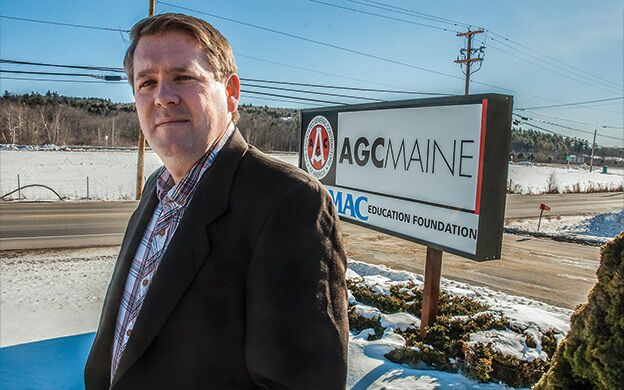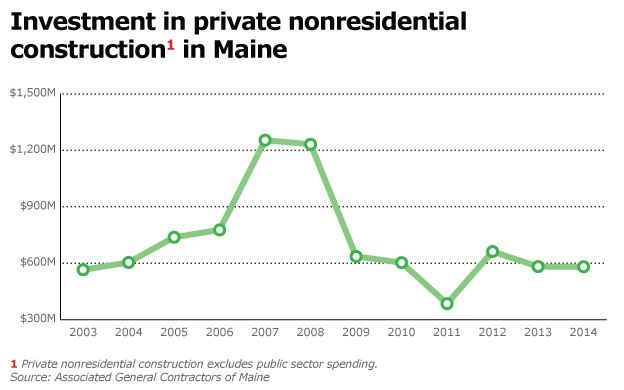Recruitment a top priority for Associated General Contractors of Maine
Matthew Marks, CEO of the Associated General Contractors of Maine, says the state's 4,700 construction firms lost 10,000 jobs since 2006, when 32,000 workers were employed in that pre-recession, peak construction year.
Matthew Marks, CEO of the Associated General Contractors of Maine, says the state's 4,700 construction firms lost 10,000 jobs since 2006, when 32,000 workers were employed in that pre-recession, peak construction year. Although construction employment now stands at 25,400, the trade group's parent organization, AGC America, ranked Maine 48th in the country for construction job growth in 2015, reporting that there were 700 fewer construction jobs in the state last June compared to June 2014.
Marks says the recession put the brakes on an initiative AGC Maine launched in 2006 to reinvigorate its education foundation and encourage Maine's students to think about careers as carpenters, electricians, welders and other construction trades. The impetus for that initiative, he says, was simple: An aging workforce creates a corresponding need to hire skilled younger workers to replace them.
Marks says AGC Maine is revamping its outreach efforts and has made recruitment of young workers a top priority of 2016.
Mainebiz interviewed Marks at AGC Maine's Augusta office to talk about that effort in the broader context of Maine's construction industry's ongoing challenges and opportunities heading into the new year. An edited transcript follows.
Mainebiz: Obviously, you've gone through some tough times since you were hired as AGC Maine's chief operations officer in 2007 and promoted to CEO in 2012. How has the long economic slowdown affected the industry's recruitment efforts?
Matthew Marks: Since I started here the construction industry has been in a very chaotic period. We went from trying to attract people [through the 2006 outreach effort] to losing highly skilled people who shouldn't have had to retire that early. We lost younger workers who had to leave the industry to find other work who should have been that next generation of workers. Instead, we lost that talent, because the economy collapsed.
MB: It was almost like a 'perfect storm'?
MM: That's what we were calling it. So we shifted focus and unfortunately we had to put a lot of that initiative on the back burner. We still wanted to be talking about these great careers, but something unprecedented had just happened. It wasn't realistic to encourage young people to enter construction when they know their uncles, their moms and dads, their cousins or whoever had lost their jobs in this field.
MB: Where are you now in terms of your recruitment initiative?
MM: We started speaking to high school guidance counselors in December. We've talked about Maine's population trends, the fact that 18% of our workforce is over the age of 55. So, if we take that, plus the 7,000 jobs lost since peak, we're looking at an increase of 11,510 jobs that we have to hit in the next five years to meet the projected needs. We've talked about the infrastructure backlog, which is tremendous. It's billions of dollars to fix all the problems we have to address. So there's plenty of work that needs to be done in this state by our member companies. And then we talk about the fact of how good these jobs are in terms of pay and becoming a career.
MB: What's the range of pay for those jobs?
MM: The average salary in Maine for construction is $45,000. That's 12% more than the average for private sector employees in the state.
But for some trades that's the low end. I'll give you one example. One of our member companies hired a couple of young kids to become welders. They put them through a welding program and this year they each made $80,000. I'm sure they worked a lot of hours, I'm sure it was tough work, but that's a great job.
MB: Do you feel that message is getting through?
MM: I think the guidance counselors didn't realize how many opportunities we have. I think when we told them how our workforce is really aging, the fact that 45% of our workforce is over the age of 45, they began to see the potential need for young workers in the next 10 to 15 years. We also told them we need kids who have exposure to the science, technology, engineering and mathematics, or STEM, skills. It's not just a matter of working with your hands.
MB: How's the construction industry today?
MM: We're seeing a steady increase in the marketplace. Folks are telling us they are starting to see more work and that they're having more of a struggle putting timelines together because there's a bit of a backlog. So that's a good sign.
All the trades are starting to tell us it's harder to find an electrician or plumber or a drywall crew. Those, to me, are problems I like to deal with. That's why this year we started to refocus back on what we were doing in 2006. That's why as an organization we're saying, 'We have to start striking the balance between steady investment in growth in Maine and bringing people into the workforce who work with their hands — who like to be outside, who are using those skills … a welder, a carpenter, a drywall or flooring guy — and putting them to work.'
What scares us a little bit is how fickle it is. We're dependent upon so many things. If the energy sector, for example, started to slow, that's a big deal. Throughout that 10-year period since 2006, when we lost 10,000 jobs, the one growing sector was energy. That was our saving grace, with more than $1 billion invested in wind energy in this state. That's been a big boost for Reed & Reed, Cianbro, Sargent and a lot of other Maine companies.
Another big one was Central Maine Power Co.'s $1.4 billion Maine Power Reliability Program. That was huge. And we've also had the natural gas work that came in late in the game. All of that combined probably saved our industry in Maine from hitting 50% in job losses.
MB: Is it fair to say workforce development and training is AGC Maine's top priority for 2016?
MM: It is one of our top priorities. The other is that we need to make sure the pipeline of work is consistent. Some of that will happen, automatically, on its own.
MB: Any thoughts on how to increase job opportunities for Maine construction companies?
MM: We believe public-private partnerships are a great opportunity to jumpstart some of the public infrastructure investment we need to make. Looking at the future, if we are going to do something above and beyond the norm in terms of tackling that infrastructure backlog, which typically involves borrowing money to fix things or increasing fees, this private-public partnership approach would be another thing you could do.
.... Everything should be on the table. Our roads and bridges are deteriorating and we're not going to catch up if we continue on the same path.
If you look right now at the three-year work plan, there's $70 million in which we're short. And that doesn't take into account the $100 million they project they'll have to borrow again to meet their current work plan. So, let's say we're short $150 million annually on transportation and infrastructure funding.
There's only a couple of ways to tackle that: 1.) More of the state budget gets dedicated to it. 2.) Or, we have to increase revenue. And the only way to increase revenue in a very straightforward way, in my opinion, is to increase the gas tax or increase tolls. Now both of those things are red herrings.
But evidence shows that we're spending more on repairing damage to our vehicles because of the condition of the roads and bridges than we would spend if we had an increase in the gas tax.
Read more
Aging workforce, lack of skilled workers leads to worker shortage in construction













Comments